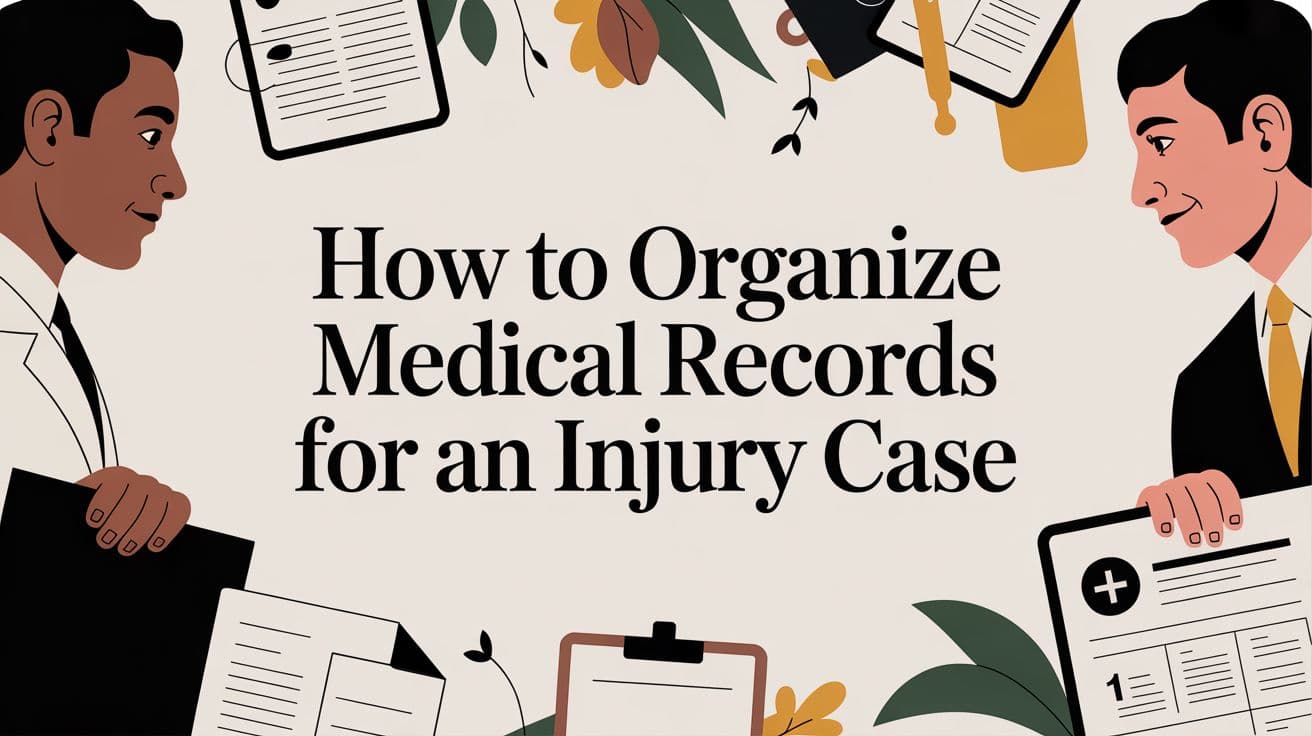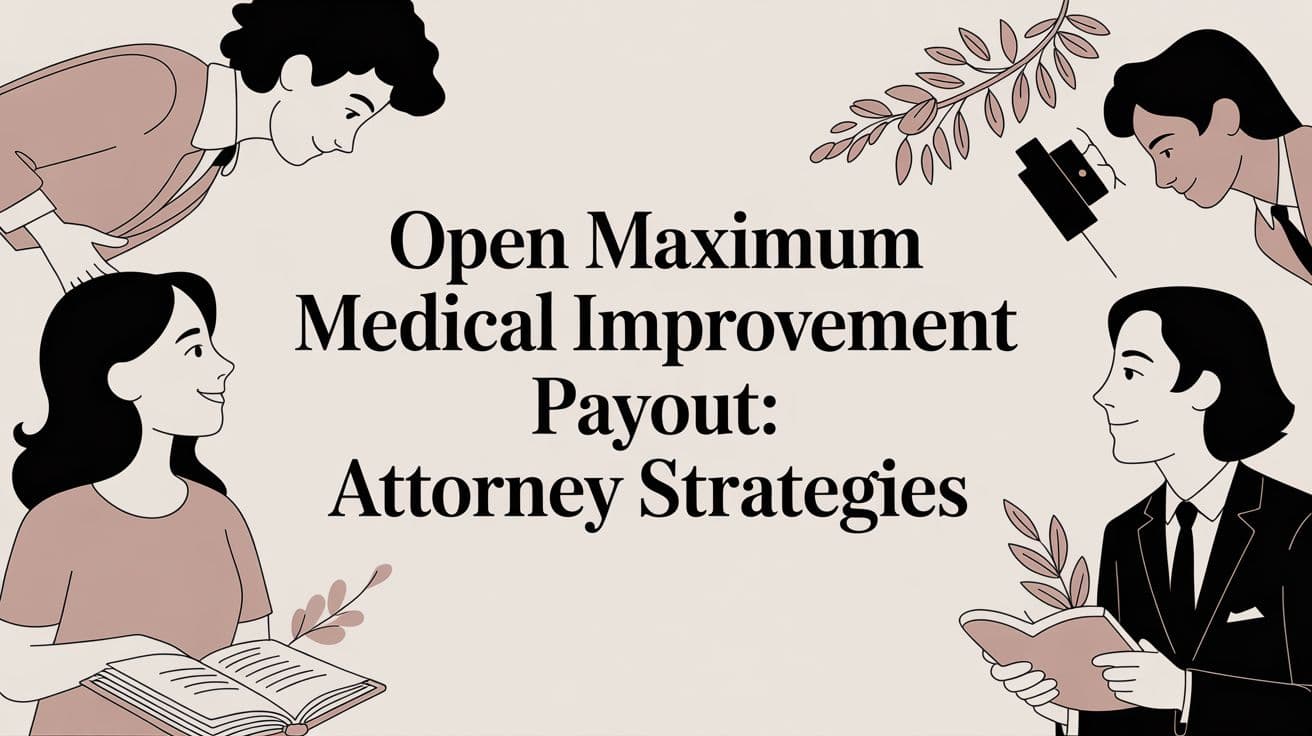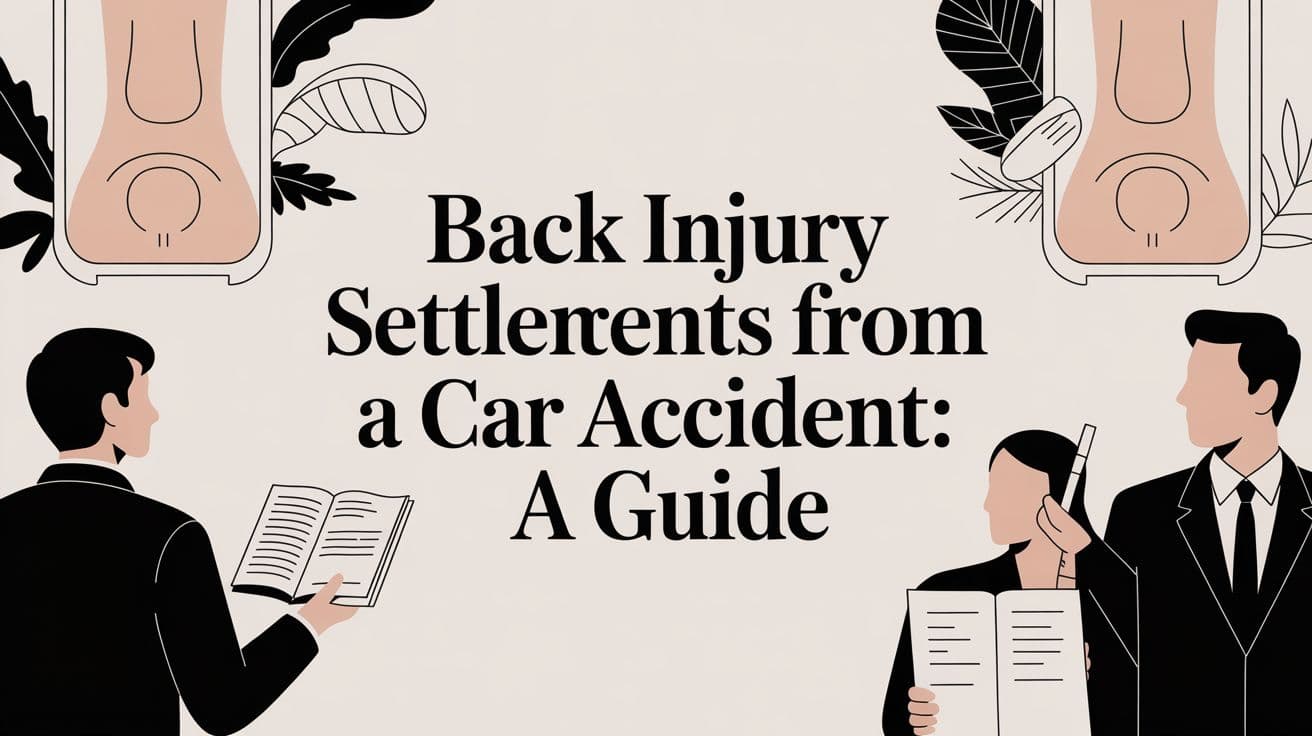How to Calculate Emotional Distress Damages: A Quick Guide
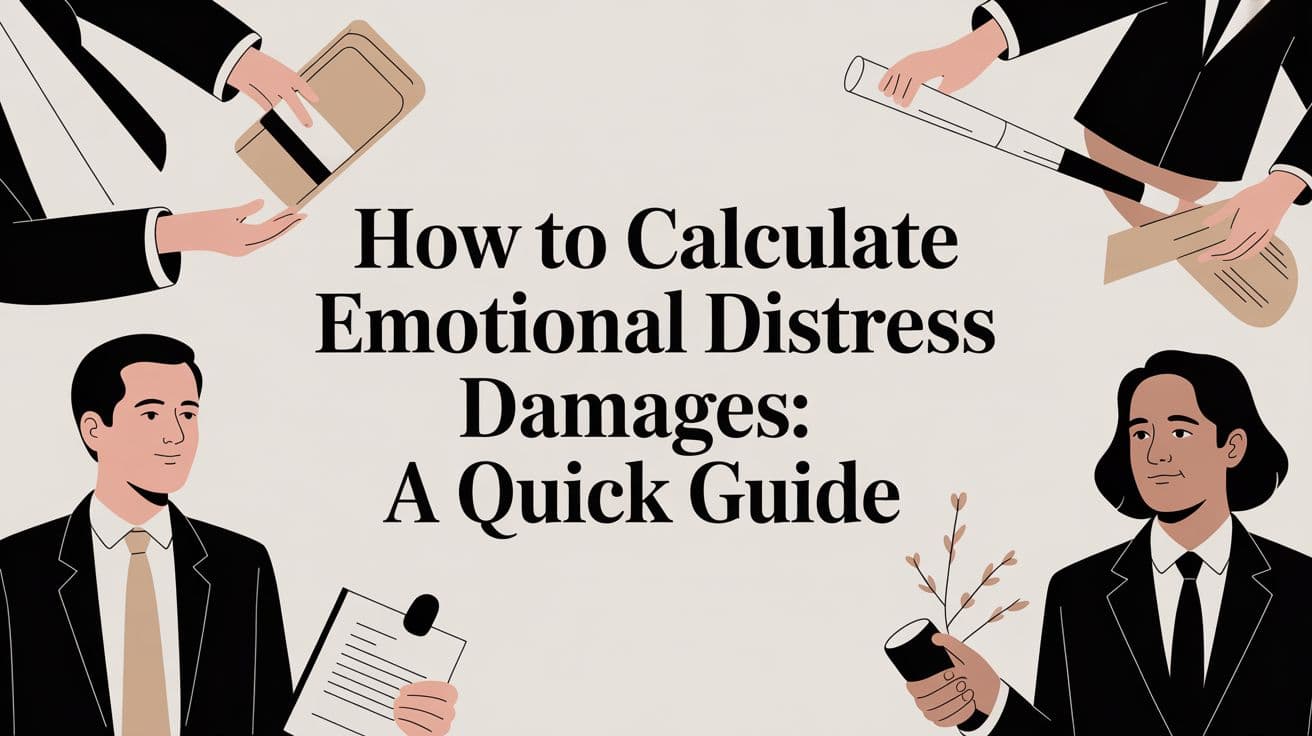
Quantifying a client's emotional distress is more art than science, but it absolutely requires a solid, evidence-based foundation. We’re talking about translating real, human suffering into a dollar amount that an insurance adjuster or jury will find reasonable. There are two go-to methods for this: the Multiplier Method and the Per Diem Method.
Let's break down how to turn your client's pain into a compelling settlement figure.
From Suffering to Settlement: A Practical Approach
Putting a number on pain is tough. It's one of the most abstract parts of a personal injury claim, but it's also where you can make a huge difference for your client. The figure you land on for a demand letter can't just be pulled out of thin air. It has to be a carefully calculated number, built on solid evidence and a clear understanding of what makes adjusters and juries tick.
Your role here is to build a narrative. You need to draw a straight, undeniable line from the defendant's negligence to your client's new, diminished reality. For a deep dive into how this calculation fits into the bigger picture, check out our guide on writing a demand letter for personal injury.
Laying the Groundwork for Your Calculation
Before you even think about a formula, you have to build your case from the ground up. This isn't just about adding up medical bills; it's about grasping the full human cost of the injury.
The Multiplier and Per Diem methods are the frameworks we use to structure this valuation.
- The Multiplier Method: This is the workhorse for cases with significant economic damages—think hefty medical bills and serious lost wages. You take those hard numbers and multiply them by a factor (usually between 1.5 and 5) to account for the pain and suffering.
- The Per Diem Method: This one is powerful when you can clearly define the period of suffering. You assign a daily value to your client’s pain and multiply it by the number of days they endured it. It makes an abstract concept feel tangible.
So, which one do you choose? It really comes down to the facts of your case. A catastrophic injury with a long road of medical treatment and permanent impairment is a natural fit for the multiplier method. On the other hand, a debilitating injury with a painful but finite recovery period might be more powerfully argued using a per diem rate.
The secret isn't just picking a method; it's about being able to defend it. An adjuster will scrutinize your number, but they are far more likely to take a high-value demand seriously if your logic is transparent, consistent, and backed by a mountain of evidence.
To really dial in your valuation, digging into case law is a must. Using a tool like an AI legal case researcher can quickly uncover precedents and jury verdicts in similar cases within your jurisdiction. This anchors your chosen multiplier or daily rate in real-world results, giving you a much stronger hand to play at the negotiating table.
Now, let's get into the mechanics of each method so you can build a claim that's designed to withstand scrutiny.
Using the Multiplier Method to Quantify Distress
When you're trying to put a number on a client's suffering, the multiplier method is one of the most reliable tools in your arsenal. It’s a practical way to ground the intangible experience of pain and trauma in the hard numbers of economic loss, giving you a defensible starting point for negotiations.
At its core, the concept is simple. You calculate the total economic damages—things like medical bills and lost income—and multiply that figure by a number that reflects the severity of your client's emotional ordeal.
Selecting the Right Multiplier
In most jurisdictions, the multiplier usually falls somewhere between 1.5 and 5. The real art and strategy lie in choosing and justifying that number. A minor injury that healed quickly with little disruption to your client’s life might only warrant a 1.5 multiplier. But for a catastrophic event that leaves lasting scars, both physical and psychological, you should be pushing for a 4 or a 5.
So, how do you justify the higher end of that scale? You build a powerful story backed by solid evidence. Several key factors can drive that number up:
- The Severity of the Trauma: A head-on collision or a brutal assault will always justify a higher multiplier than a minor fender-bender.
- Long-Term Psychological Harm: This is where your documentation is crucial. A formal diagnosis of PTSD, chronic anxiety, or severe depression provides a powerful anchor for your argument.
- Ongoing Medical Treatment: If your client needs long-term therapy, counseling, or psychiatric medication, it clearly demonstrates a sustained and significant level of distress.
- Permanent Scars or Disfigurement: Visible scarring or a permanent physical disability carries a profound and lifelong emotional burden that must be compensated.
This decision tree illustrates how the presence of clear economic loss makes the multiplier method a go-to strategy.

As the graphic shows, once you've established economic damages, the multiplier approach becomes one of the clearest paths to valuing the non-economic side of the claim.
A Practical Scenario
Let's walk through an example. Your client was a passenger in a rideshare that was T-boned, leaving her with a fractured femur and deep lacerations across her face.
First, you tally up the special (economic) damages:
- ER visit and orthopedic surgery: $45,000
- Follow-up appointments with the surgeon: $8,000
- Consultation with a plastic surgeon for scarring: $2,500
- Months of physical therapy: $6,000
- Lost wages while unable to work: $12,000
- Total Economic Damages: $73,500
Now comes the crucial part: choosing the multiplier. Your client has developed a debilitating fear of getting into a car. She has nightmares about the crash and is seeing a therapist for anxiety. The facial scarring has made her withdrawn and deeply self-conscious, impacting her social life.
Given the ongoing psychological treatment, the permanent nature of her scars, and the profound impact on her quality of life, a multiplier of 4 is not just reasonable—it’s necessary. Anything less would fail to capture the true extent of her suffering.
With that, the calculation for the emotional distress portion of the demand is straightforward:
$73,500 (Economic Damages) x 4 (Multiplier) = $294,000 (Emotional Distress Damages)
This brings your total settlement demand to $367,500 ($73,500 in specials + $294,000 in general damages).
Defending Your Chosen Multiplier
Remember, a number is just a number until you back it up. Your calculation is only as strong as the evidence you bring to the table. While there are helpful tools for quantifying distress that can help organize your calculations, the real work is in the documentation.
You need to be ready to present the adjuster or jury with a detailed chronology of symptoms, notes from therapists, reports from psychiatric evaluations, and even statements from family and friends who can speak to the changes they've seen in your client. Every piece of evidence works to transform your demand from a seemingly arbitrary figure into a well-reasoned valuation of what your client has truly lost.
Calculating Daily Suffering with the Per Diem Method
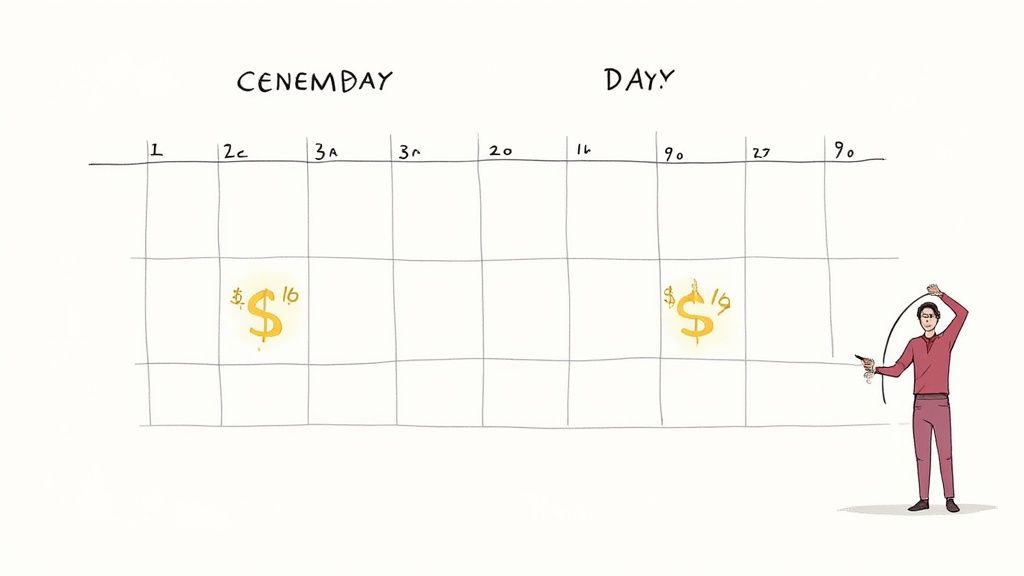
While the multiplier method ties pain and suffering to economic damages, the Per Diem method offers a more direct, day-by-day valuation. It's an incredibly powerful tool because it translates an abstract concept—suffering—into a clear, daily monetary rate that adjusters and juries can easily grasp.
This approach works best when you can clearly define the period of suffering. You're essentially creating a narrative that assigns a specific dollar value for each day your client had to endure pain, anxiety, and a diminished quality of life. Think of it as demanding a daily wage for the grueling "job" of enduring the consequences of an injury.
Establishing a Justifiable Daily Rate
The entire strategy hinges on setting a daily rate that is both reasonable and, most importantly, defensible. If you just pull a number out of thin air, your demand will be dead on arrival.
The most effective way I've found to anchor this rate is to tie it directly to your client’s daily earnings. The logic here is simple and persuasive: if society agrees a person deserves $200 for a day's work, it’s entirely reasonable to argue they deserve at least that much for a day of debilitating pain that keeps them from working, playing with their kids, or simply living their life.
For example, a client who earned $52,000 a year had a daily earning rate of about $200 (based on 260 working days). Using that figure as the per diem rate for suffering creates a logical and compelling starting point for negotiations. It connects the intangible loss to the client's own established economic value.
The Crucial Role of Documentation and Duration
A solid daily rate is just one part of the puzzle. The other is meticulously documenting the exact duration of the suffering. This isn't a timeline you get to estimate; it must be grounded in cold, hard medical evidence.
The clock starts ticking on the date of the incident and stops when the client reaches what we call Maximum Medical Improvement (MMI). This is the critical point where a physician officially determines that the client's condition has stabilized and isn't expected to get significantly better.
The per diem method’s power comes from your ability to prove the duration of suffering. A detailed, evidence-backed timeline—supported by medical records, physical therapy notes, and psychological evaluations—turns the calculation from a theory into a documented reality of your client’s daily struggle.
This means you need to comb through all the medical paperwork to lock down these key dates:
- Date of Incident: The clear starting point.
- Key Treatment Milestones: Dates of surgeries, significant procedures, or the beginning of intensive therapy.
- Physician’s MMI Declaration: The official end date for your calculation, which you'll find explicitly stated in the medical records.
This documented timeline gives you the precise number of days for your calculation, leaving no wiggle room for the other side to argue hypotheticals.
A Real-World Per Diem Calculation
Let's walk through a common scenario. Imagine a construction worker who earns $65,000 annually suffers a severe back injury after a fall from faulty scaffolding.
Determine the Daily Rate: We take his $65,000 annual salary and divide it by 260 workdays. This gives us a daily wage of $250, which becomes our proposed per diem rate for his pain and suffering.
Establish the Duration: The accident happened on January 15th. After undergoing surgery and months of physical therapy, his orthopedic surgeon declared he reached MMI on September 20th of the same year. The total duration of his recovery and suffering is 248 days.
Calculate the Total Award: Now, the math is straightforward. You multiply the daily rate by the number of days.
$250 (Daily Rate) x 248 (Days of Suffering) = $62,000 (Emotional Distress Damages)
This calculation is clean, easy to explain, and tough to argue with because every variable is tied to objective proof: the client’s verifiable income and the physician’s documented timeline. When you present a demand this way, you're not just asking for a number; you're showing the adjuster or jury exactly how you got there, building the credibility needed to justify your demand.
Building Your Case with Compelling Evidence
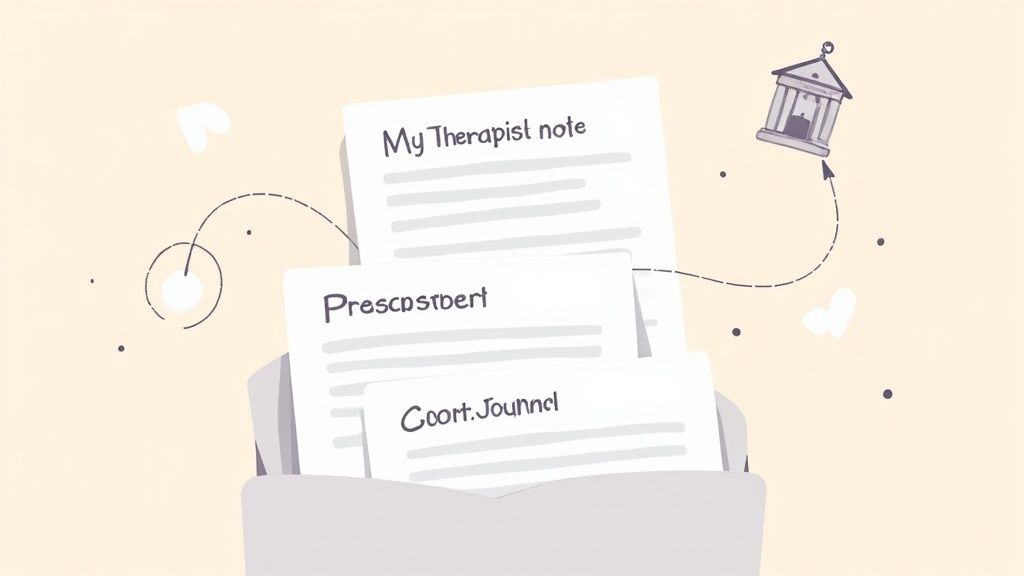
A demand for emotional distress damages is just a number on paper until you back it up with irrefutable proof. It doesn't matter if you're using a multiplier or a per diem calculation; your ability to get a fair settlement comes down to how well you gather and present your evidence.
Think of it this way: insurance adjusters are professional skeptics. Their goal is to poke holes in your argument and minimize what they have to pay. Your job is to construct a narrative so airtight and evidence-backed that it leaves no room for doubt. This means connecting the defendant's negligence directly to your client’s suffering using both medical and non-medical proof.
The Foundation: Medical Documentation
Medical records are the bedrock of any emotional distress claim. They provide the objective, third-party validation that turns a client's subjective pain into a diagnosable, compensable injury. Simply saying a client is anxious won't cut it. You need to show a documented diagnosis from a licensed professional.
The most powerful medical evidence usually includes:
- Psychiatric Evaluations: A formal assessment from a psychiatrist is gold, especially if it leads to a diagnosis like PTSD, Major Depressive Disorder, or Generalized Anxiety Disorder.
- Therapist and Counselor Notes: These records create a running log of your client's struggles, detailing symptoms, how they affect daily life, and the course of treatment.
- Prescription Logs: A list of medications prescribed for anxiety, depression, or insomnia is concrete evidence of a real, treated condition.
- Primary Care Physician Records: Don't forget these. Complaints of sleeplessness or panic attacks made to a family doctor can establish an early timeline of symptoms, often before a client even seeks specialized mental health care.
Getting these documents organized is a critical first step. A messy file means missed details and a weaker argument. To learn a structured approach, check out our guide on how to organize medical records and build the strongest possible case narrative.
Bringing the Story to Life with Non-Medical Proof
While medical records lay the clinical groundwork, non-medical evidence is what makes an adjuster—or a jury—truly understand the human cost of the injury. This is how you move past clinical terms and show the real, day-to-day impact on your client's life.
A personal journal can be one of the most powerful tools in your arsenal. Encourage your client to document their daily experiences—not for litigation, but as a therapeutic outlet. This process also happens to create an incredibly authentic, real-time record of their struggles.
A client’s own words, written in the moment of frustration or fear, often resonate more than any expert report. An entry describing a panic attack while driving past the accident scene provides a raw, undeniable account of their suffering.
Beyond the client's own words, look to their inner circle. Testimony from family, friends, and coworkers can be incredibly persuasive. These are the people who knew your client "before" and can speak to the profound changes they've seen "after." A statement from a spouse describing how their once-outgoing partner is now withdrawn, or from a manager noting a sharp decline in concentration, corroborates the client’s claims and shows just how far the emotional damage reaches.
To help you systematically gather these crucial pieces, here is a quick reference table.
Evidence Checklist for Emotional Distress Claims
This table outlines the key documents and information needed to build a robust and well-supported claim for emotional distress damages.
| Evidence Category | Specific Examples | Purpose in Claim |
|---|---|---|
| Medical Documentation | Psychiatric evaluations, therapy notes, prescription records, PCP notes on anxiety/depression. | Provides objective, third-party validation of a diagnosed mental health condition. |
| Client's Personal Records | Daily journal, symptom logs, personal calendars noting missed events or appointments. | Offers a contemporaneous, firsthand account of the client's daily struggles and suffering. |
| Third-Party Testimony | Statements from spouses, family members, friends, coworkers, and employers. | Corroborates the client's claims and illustrates the tangible impact on their relationships and work. |
| Financial Records | Receipts for therapy co-pays, medication costs, pay stubs showing lost wages from missed work. | Quantifies the direct financial costs associated with treating the emotional distress. |
| Visual Evidence | Photos or videos showing changes in lifestyle, such as a once-active client now housebound. | Creates a powerful visual narrative that complements written and oral testimony. |
Using this checklist ensures you cover all your bases, from the clinical diagnosis to the human impact.
Weaving It All Together
Your final task is to weave these different threads of evidence into a single, compelling story. Don't just dump a pile of records on the adjuster's desk. You need to guide them through the evidence, connecting the dots for them.
A great way to do this is by creating a detailed symptom chronology. Start your timeline on the date of the incident and track every new and worsening symptom, linking each one to a specific doctor's visit, diagnosis, or life event. This visual roadmap makes the cause-and-effect relationship between the accident and the trauma impossible to ignore.
For instance, you can map the initial ER visit to the first prescription for an anti-anxiety medication, then connect that to the start of therapy, and finally to a formal PTSD diagnosis. Each point on the timeline reinforces the next, building a logical and undeniable progression of harm. By combining hard medical facts with compelling human stories, you turn a simple number into a justified demand that reflects the true toll on your client's life.
Navigating State Laws and Damage Caps
Trying to calculate emotional distress damages without first understanding your state's specific laws is like navigating a minefield blindfolded. What flies in California might get thrown out of court in Texas. It's a patchwork of rules, and a one-size-fits-all approach just doesn't work.
Ignoring local statutes and case law is a rookie mistake. You don't want to be the attorney who builds a powerful case for $500,000 in emotional distress, only to find out your state has a hard cap of $250,000 for non-economic damages. This research isn't a final-step checklist item; it’s one of the very first things you do.
Ultimately, your jurisdiction provides the essential filter through which every calculation and every piece of evidence must pass. It dictates not just how you calculate these damages, but how much your client can realistically hope to recover.
Don't Get Blindsided by Statutory Damage Caps
One of the biggest hurdles you'll face is a statutory cap on non-economic damages. A growing number of states have put legal ceilings on how much a plaintiff can get for pain, suffering, and emotional anguish—especially in med-mal cases.
These caps aren't suggestions; they are a hard limit on your client's recovery, no matter how horrific their suffering or how airtight your evidence is. Some states set a flat dollar amount, while others might tie it to a multiple of the economic damages.
You have to identify these caps right away. Knowing the ceiling shapes your demand, guides settlement talks, and, most importantly, helps you set realistic expectations for your client from the very beginning.
Don't just look for a number, either. Dig into the details of the statute. Does the cap apply to every personal injury case, or just claims against government bodies? Are there carve-outs for catastrophic injuries? The devil is always in the details.
Know Your Jurisdiction’s Standard of Proof
Beyond the dollar limits, states have very different ideas about what actually counts as compensable emotional distress. This is a critical distinction, and you absolutely must know which standard your jurisdiction follows. It will define your entire evidence-gathering strategy.
The Physical Manifestation Rule: Some of the tougher states require you to show a clear physical symptom resulting from the emotional distress. Think stress-induced ulcers, debilitating migraines, or even hair loss. This is often called the "impact rule," and without that physical link, the claim is a non-starter.
The Zone of Danger Rule: Other states are a bit more flexible. They allow recovery if your client was in the immediate "zone of danger" and feared for their own safety, even if they weren't physically touched. This is common in cases where a parent witnesses a traumatic injury to their child.
Standalone Emotional Harm: A handful of states allow claims for severe emotional distress without any physical impact at all, but only if the defendant's conduct was truly outrageous. These are typically pursued as standalone NIED (Negligent Infliction of Emotional Distress) or IIED (Intentional Infliction of Emotional Distress) claims.
Settlement data backs this up. In cases where emotional distress is tied to clear physical injuries, multipliers tend to hover in the 1.5 to 3 range. But for catastrophic injuries or severe, well-documented psychological trauma, those multipliers can easily jump into the 3 to 5 range. You can see more on how these standards play out by reviewing insights on emotional distress damages in Texas.
Knowing the standard of proof is everything. In a "physical manifestation" state, you’ll need to be relentless in documenting every related physical symptom. In a "zone of danger" state, your focus shifts to proving your client’s proximity and fear. A tailored approach isn't optional—it's essential.
Common Questions About Emotional Distress Claims
Even after you've mastered the calculation methods, some tricky, real-world questions always pop up when you're handling emotional distress claims. These nuances can make or break a case, but if you see them coming, you can prepare your client and build a much stronger argument. Let's walk through some of the most common issues I see in my practice.
Having clear answers ready for these isn't just about managing client expectations. It’s about building a bulletproof strategy and shutting down the defense's arguments before they even make them.
Can a Client Claim Emotional Distress Without a Physical Injury?
The short answer is yes, but it’s an uphill battle. When you’re dealing with purely emotional harm—without a single physical scratch to point to—you're stepping into the territory of specific torts like Intentional Infliction of Emotional Distress (IIED) or Negligent Infliction of Emotional Distress (NIED).
These aren't your everyday personal injury cases. For an IIED claim to stick, you have to prove the defendant's actions were more than just careless; they have to be truly extreme and outrageous. For NIED, the rules are all over the map depending on the state, but they often require your client to have been in the "zone of danger" or to have witnessed a horrifying event befall a close family member.
The bar for evidence on these standalone claims is set incredibly high. In a standard injury case, emotional distress is an expected part of the damages. But in an NIED or IIED claim, it is the entire case, and that requires a much more compelling and detailed body of proof.
How Does a Pre-existing Mental Health Condition Affect a Claim?
It definitely makes things more complicated, but it's far from a dealbreaker. This is where you lean heavily on the "eggshell plaintiff rule"—the principle that the defendant has to take the victim as they find them, pre-existing vulnerabilities and all.
The real work is in untangling causation. Your job is to meticulously separate the client's baseline mental health from the new or worsened suffering caused by the defendant's negligence. This demands a forensic-level review of their entire medical history. I've found that creating a detailed medical record summary is the best way to get organized and build a clear, defensible timeline. It helps you isolate exactly how the defendant’s actions aggravated the pre-existing condition, drawing a bright line for the adjuster or jury to follow.
Are Emotional Distress Damages Considered Taxable Income?
This is a classic "it depends" scenario, and it's crucial you get it right for your client. The IRS is pretty clear: damages received for emotional distress that stem directly from a physical injury or physical sickness are generally not considered taxable income. This is a huge relief for most clients.
However, the game changes if the award is for emotional distress alone. If there’s no underlying physical injury—think defamation or a standalone IIED case—that money is usually considered taxable. The only exception is that any portion of the settlement specifically for medical expenses used to treat the emotional distress is typically non-taxable.
- Tied to a Physical Injury: Not taxable.
- Standalone Emotional Harm: Taxable.
The tax code is a minefield, so my standard advice is always the same: have your client talk to a tax professional. It ensures they handle their settlement money correctly and don't get a nasty surprise from the IRS later on.
At Ares, we know that a powerful emotional distress claim is built on solid medical evidence. Our AI platform transforms dense medical records into the clear summaries and chronologies you need to pinpoint the proof and justify your demand. Stop wasting hours on manual review and start building stronger cases. Check us out at https://areslegal.ai.
